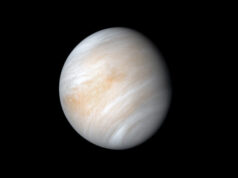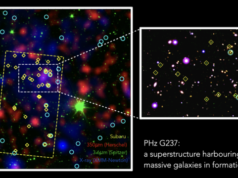A new study on the kinematics and chemical composition of a sample of stars in the vicinity of the sun, led by Dr. Daniela Carollo, researcher of the Italian National Institute for Astrophysics, has revealed that the stars that make up the thick disk of the Milky Way belong to two distinct stellar populations with different characteristics and not to a single one, as has been thought for more than two decades.
The new thick disk component, called the metal-weak thick disk (MWTD) or metal-poor thick disk, differs from the canonical one in the speed of rotation around the galactic center and its chemical composition. Indeed, stars that make up the TD have a rotational speed of about 180 km per second, while those of the MWTD rotate more slowly, at about 150 km per second. Stars belonging to the MWTD are also two times more metal-poor than those of the TD and have higher energy, a property that allows them to reach greater heights from the galactic plane.
“It was almost 30 years that astronomers tried to solve this puzzle,” said Dr. Carollo, scientist at the Astrophysical Observatory of Turin the first author of the article reporting the discovery, just published in The Astrophysical Journal. “In fact, it was thought that the MWTD was nothing but an extension of the thick disk and not an independent population with different astrophysical origins.”
The accurate parameters provided by the ESA Gaia mission (positions, distances and intrinsic motion of the stars), and the chemical information on a sample of 40,000 stars of the Sloan Digital Sky Survey (SDSS), allowed the team to distinguish the MWTD in a diagram showing the angular momenta combined with the chemistry.
“The angular momenta are quantities that are conserved during the formation and subsequent evolution of a physical a system like our galaxy,” explains Dr. Carollo. “Thus, in an accurate diagram of the angular momenta, the stars brought into the galaxy by the same progenitor, as for example from a previous fusion of a satellite galaxy, will have similar angular momenta and will tend to cluster in the diagram.”
Find your dream job in the space industry. Check our Space Job Board »
The TD and MWTD form two distinct groups in the diagram, as well as in their chemistry. In astronomy, the chemical elements heavier than hydrogen and helium, which were formed during the Big Bang, are defined as metals. These heavier chemical elements were produced during the nucleosynthesis of massive stars that exploded as supernovae.
A particular group of light elements such as magnesium and titanium, when compared to heavier elements, such as iron, provide a fundamental parameter that allows scientists to distinguish populations of old stars from those of younger stars. The MWTD not only possesses stars poorer in iron, but those stars are also richer in elements of the magnesium and titanium group (alpha elements) that suggests an antecedent formation to the TD.
These important differences between the TD and the MWTD, namely the kinematics and the chemistry of their stars, suggest that the two disks had a different origin during the galaxy formation process.
But how did a second thick disk form in the Milky Way? The hypotheses are manifold: the MWTD could be older than the TD and its stars could have been energized by a merger of a dwarf satellite galaxy with the Milky Way, during its initial formation stage. Subsequently, the fusion of a second satellite galaxy would have given rise to the TD.
Another possibility is that the MWTD stars had originally formed in an area closer to the center of the primordial galaxy and subsequently been transported to larger distances, closer to where the sun is located now, by internal phenomena such as instabilities of the central bar or the galaxy’s spiral arms formation. Or an ancient satellite galaxy of mass similar to the Small Magellanic Cloud merged with the primordial galaxy and its stars began to spin around the galactic center due to the mutual gravitational interaction.
All these hypotheses can be tested through theoretical models and simulations of Milky Way-like galaxy formation.
Provided by: Istituto Nazionale di Astrofísica
More information: Daniela Carollo et al. Evidence for the Third Stellar Population in the Milky Way’s Disk. The Astrophysical Journal (2019). DOI: 10.3847/1538-4357/ab517c
Image: The Milky Way from the Andes in Chile.
Credit: G. Hüdepohl/ESO











